by Tom Gaylord
Writing as B.B. Pelletier
This report covers:
- Haenel history
- Haenel 100
- Not a BB pistol?
- Odd way of cocking
- Nickel finish
- Crude sights
- Shot tube
- Functioning
- The future
Haenel history
Of the many European airgun manufacturers, only a few like Walther, Feinwerkbau and Diana are well-known to American airgunners. Other makers like Falke of Germany and Peiper of Belgium produced airguns in quantity, but they escaped our notice. The greatest of these makers was perhaps the Haenel company that was founded by Carl Gottleib Haenel in 1840. By the 1930s, Haenel was producing many models of air rifles that would become collector favorites a half-century later in the U.S. I have reviewed a few of these rifles for you already. There was the Haenel 310 bolt action target rifle that shoots 4.4mm lead balls. That one came into the U.S. after the Wall fell in 1989. The East German Stasi used them as youth trainers and when the Germans took over they sold them as surplus.
Then there was the Haenel 303-8 Super that was a breakbarrel made into a target rifle. I found it to be reasonably accurate and fun to shoot. It reminded me a lot of the Haenel 311 bolt action target rifle that I also reviewed for you. That one is a very accurate and capable target rifle, though not quite in the world class category.
I also took a quick look at Haenel’s model iii-284 breakbarrel rifle. That one was a pre-war model that was in the Diana 27 class for power. I also looked at the Haenel model 1 — another older breakbarrel with some curious features not found on other airguns on similar price.
I have covered Haenel air rifles pretty well over the years. The one model I would like to test someday is a Haenel model 312 target rifle. This sidelever spring gun is even more of a target rifle than the 311. I have seen them at airgun shows but I never had the money when I saw one. Another Haenel I have owned 2 of and never reported is the model 28 pistol — the one people think was a trainer for the Luger. I sold my last one about a year ago, but when I get another one I plan to report on it for you.
Haenel 100
Today, though my report is on the Haenel 100 — a very odd BB pistol whose major claim to fame in my book is the fact that one was found in the quarters of a German submarine captain when his boat was captured in WW II. He was apparently shooting targets with it in those cramped quarters!
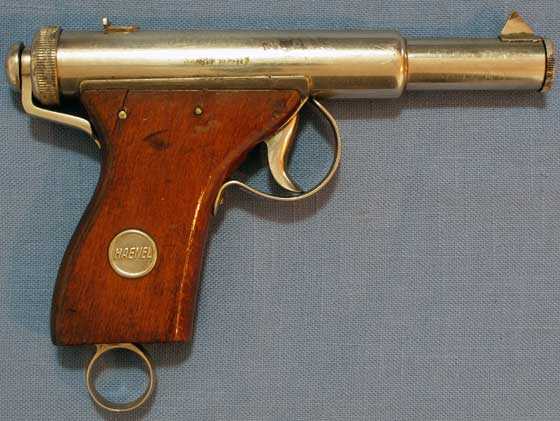
The Haenel 100 BB pistol is a pre-war 50-shot repeater.
Not a BB pistol?
The model 100 was made from 1932-1940, according to the Blue Book of Airguns. And I am so glad I looked it up, because I always through this was a true BB pistol. It turns out the model 100 and the models 50 and 51, which are simpler versions of the gun, all use 4.4mm lead balls instead of smaller steel BBs. Fortunately I laid in a big supply of that shot when I acquired my 310 rifle years ago. I buy more whenever I see it for sale at airgun shows.
I guess it isn’t really correct to call the 100 a BB pistol, since it really isn’t made to shoot conventional steel BBs. I will continue to refer to it that way, though, because that’s how most people will know it.
Odd way of cocking
The pistol cocks in an odd way. Actually all Haenel air pistols cock in odd ways. This one has a ring under the bottom of the grip. You grab the one-piece wooden grip in one hand and pull the ring away from it with the other hand. The ring is on the end of a weird lever system that retracts the cocking piece. That compresses the mainspring. You have to see it to believe it!
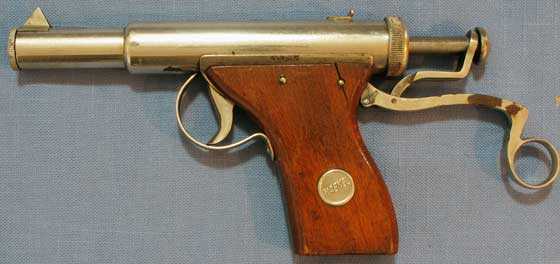
Pull the ring back from the grip and this happens.
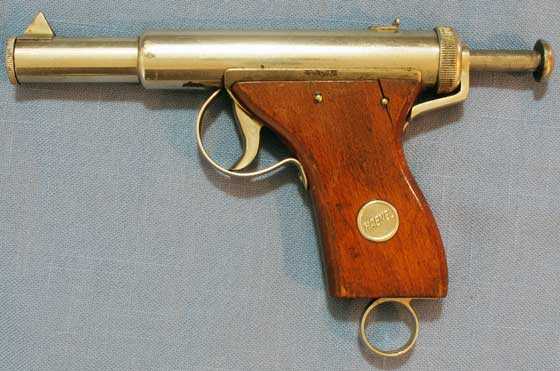
Return the ring and the cocking piece stays back until the gun is fired.
The models 50 and 51 have a cocking piece at the back, but no lever is connected. You just pull the cocking piece back to cock the gun. But the 100’s spring is much stronger and this would be difficult to do.
Nickel finish
The 100 came with either a blued or a nickeled finish. I have never seen a blued gun, though I have only seen 20 or less model 100s in total. They are not that common in this country. I’m guessing the blued gun may be even harder to find than the nickeled one.
My gun retains about 87 percent of the bright nickel. The plating has flaked off in a couple places and rust has started, so I wiped the gun with Ballistol to stabilize the rust. The beechwood grip is a single piece that has metal Haenel eschtchons on both sides. It is held to the frame by two steel pins and the wood has cracked around the rear pin. Looking at how it’s made, I suspect this crack is common to this model.
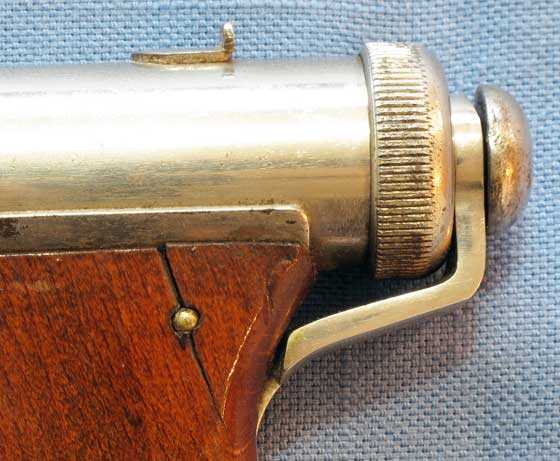
The one-piece wood grip is pinned to the frame. The crack around the rear pin is on both sides of the grip and seems to be there because the wood grain is straight and weak at that point.
Crude sights
The sights are very crude and are probably silver-soldered to the spring tube. No adjustment is possible and they aren’t easy to see. I can appreciate why the submarine captain shot at such close range! I will, too.
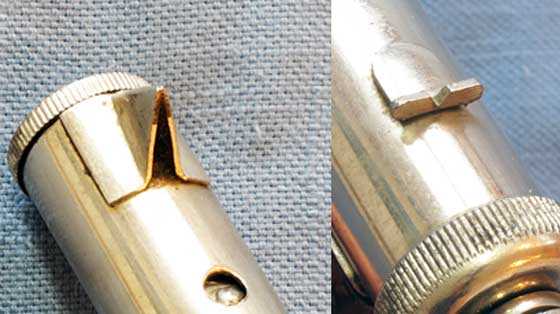
The sights are very crude and not adjustable. They are attached to the barrel jacket.
Shot tube
The gun has a conventional shot tube that feeds by gravity. It resembles a Daisy shot tube, except the length is shorter. When the tube is rotated it opens a hole on top of the barrel jacket where lead balls can be loaded one at a time. The idea of a speedloader was still a half-century away when this gun was new… The gun is rated to hold 50 balls. I never tested that and I don’t plan to.
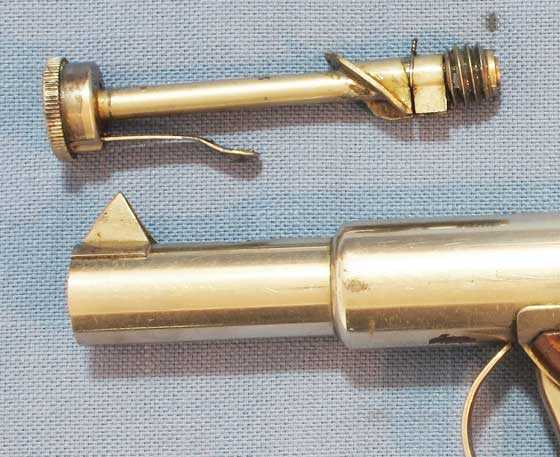
The shot tube looks like one from a Daisy, just shorter.
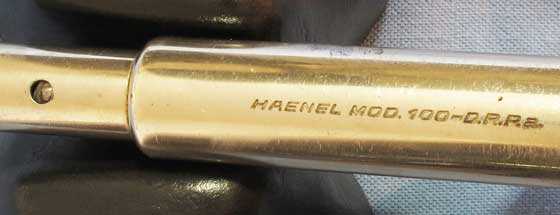
BBs feed through the hole on the left. The shot tube rotates out of the way, opening the hole.
This is an older airgun that has some quirks. The first quirk is it’s very hard to cock. I oiled the mechanism and the cocking hinge points, but it still takes a strong adult to cock it. I oiled the plunger (piston) seal because it is undoubtedly leather. I stood the pistol on its butt to let the oil soak into the leather for a day before any shooting was attempted. Who knows how long it’s been since the seal was oiled last?
A second quirk is the trigger doesn’t always set itself when the gun is cocked. Probably a spring is broken or missing, but the gun is too nice to mess with. I know how to set the trigger every time, so I just do it.
Finally the pistol doesn’t always feed a ball. I grew up with that problem in Daisy BB guns that use gravity feed, so I’m used to it. There is a way of holding the pistol when it is cocked so it will feed more reliably, and that’s just part of getting used to the gun.
Functioning
The gun has a very heavy trigger pull that I don’t have the right instrument to measure. I’ll guess it’s around 15-18 lbs., or so. I’m not going to take it apart, but if I did I would find a direct-acting sear that has very little opportunity for improvement. That’s how all similar guns of the same period were made.
It recoils when it fires. And the lead ball smacks the cardboard target backstop with the authority of a ball traveling 200-250 f.p.s. That’s what I would expect from a BB pistol of this age and make. We will find out next time for certain because I plan to test the gun for you — both for velocity and accuracy.
The future
So far I have only done one other test report about a specific airgun in this history section. That was on the Parris Kadet 500 BB gun. Now I think it’s time to expand on that. With a few of the basics out of the way, we can focus on a specific model, now and then. The test I do won’t be as long or detailed as a test report for a new airgun, but it will cover velocity and accuracy if I am able. I won’t run Part 2 next — I’ll give you a breather for those who aren’t as interested in this gun. But for everybody — including me — we’re going to find out how these things shoot!

I think that is a gorgeous airgun. Very basic, and with the wood and brass color–it looks like a nautical instrument.
How much is an airgun like that worth, if you could find one?
Rco1234,
The one shown in the BlueBook shows 60~300$. The one in the book has a checkered grips with the checkering in 2 distinct areas above and below the emblim. Looks very nice. The pins that BB mentioned are not there so they must have done it another way. It would be interesting to know if the checkered one was a “deluxe” model or perhaps it was an earlier run or maybe a later model.
Rco1234,
This is where a Blue Book comes in handy. According to mine, this pistol should sell for around $250. I see them at airgun shows occasionally, but seldom in this condition. Those guns are offered at $150-225.
B.B.
I like it too! But I’d want the trigger to set itself and apply moly paste liberally to all trigger and cocking parts for ease of use.
Cool little shooter!
Can’t wait for part 2!
speaking of part 2, I never found a part 2 on your 2200 Magnum.
Reb,
/blog/2009/03/testing-the-crosman-2200-part-3/
Find it with the search box at the top right.
B.B.
Thanks for the link! The search box can be hit or miss most of the time, I did find it that way earlier today and was surprised to do so.
Do you still have it?
It seems as though some valve tuning may be of benefit. I’ll be using the link as I progress with my rebuild.
BB,
The picture of the shot tube was nice. Thank you for doing a little disassmbly to give us a view of the insides. In the picture, there appears to a piece of wire that has been twisted and clipped. What does that wire hold in place? If in fact that is what it is,….that is a very interesting production method. Looks to be something more of “home” fix, but nicely done.
Thanks, Chris
Chris,
The wire is part of a spring clip to hold the lead balls in place until you fire so they do not roll out the barrel. You will see that on the older Daisys before they standardized on steel BBs and inserted magnets.
BB,
That barrel assembly is almost identical to the one in my Daisy 99. I wonder who had the idea first?
RR,
Daisy, almost certainly. I think the rest of the world copied them heavily. Fred LeFever, their designer, was the John Browning of the folded metal BB gun world.
B.B.
Off subject, but do you have any idea where to get the cone shaped breech seals used in the Industry Brand side lever and under lever cocking airguns? Do you know if any of the other side and under lever airguns breech seals will interchange?
Jonah,
Have you tried Pyramyd Air? They bought Compasseco, who was the largest importer of those airguns and they got tons of parts in the deal.
B.B.
BB,
Very interesting review so far – I have not seen one of the model 100’s in person. Yours is in very good shape for its age; is must not have been shot very much over the years. If the 100 produces 250 fps it will have the same performance as a typical BB long gun but in a much smaller package. It’s a shame the trigger is so heavy.
For some reason I like the Haenel airguns; I now have a 303, two 310’s, a Model 1, and a 28R pistol. Looking forward to the rest of the test!
Paul in Liberty County
Pau;,
I think you like Haenels because they are well-built, just like the Dianas of the same era.
B.B.
Indeed. I have the Model 1 apart right now – it needs a new piston seal – and it was built to last for a very long time. The 28R is also every bit as solid as my Walther PPK.
The other thing I like is that most Haenel models are still relatively inexpensive for the build quality you get. My second 310 has the “improved” trigger – it is MUCH better than the direct sear unit. I did not know that those existed until a couple of months ago.
Paul in LIberty County
Its a lot like an older better made Oklahoma I mentioned long ago, underlever but very similar and definitely the same purpose. I have the remnants of a daisy 188 pistol I found in a junk pile but missing to many parts to evem try, somebody took it apart and left out EVERYTHING or used it elsewhere and threw away the shell that looked like a bb gun. Lol, bummer, but new guns serving the same plinking function are 20$ at Box World. I wonder if the blued versions didnt survive because early blueing wasnt as good at protecting the steel? Especially If the sea was a common home for those that made it across the lake?
“…for I have a conviction that to be a sportsmen is a long step in the direction of being a man. … While other boys are whirling in the latest jazz or telling dubious stories on the street corner, I’d like to think that mine are deep in the lonely hills, listening to another kind of music, learning a different kind of lore. … If the sentimentalists were right, hunting would develop in men a cruelty of character. But I have found that it inculcates patience, demands discipline and iron nerve, and develops a serenity of spirit that makes for a long life and long love of life. And it is my fixed conviction that if a parent can give his children a passionate and wholesome devotion to the outdoors, the fact that he cannot leave each of them a fortune does not really matter so much. They will always enjoy life in its nobler aspects without money and without price. They will worship the Creator in his mighty works. And because they know and love the natural world, they will always feel at home in the wide, sweet habitations of the Ancient Mother.” – Archibald Rutledge -Why I Taught My Boys to be Hunters- *just a little reminder to get outside today!
I met a Catholic priest in Minnesota who told me that going out in the woods hunting made him feel closer to God. However, he was staying at St. John’s College at the time, and the monks reamed him out for being late to their functions. They are apparently very strict in those things; they make late monks stand in a corner.
Matt61
Im spiritual, believe in God and Jesus, but not religious, but if I did have a religion, it couldn’t have a forced schedule, I’d be doomed!
I can bond with the U-boat captain, shooting in confined spaces. As was mentioned in a blog post a long time ago, one of the joys of airgunning is miniaturization.
Speaking of trigger pulls, I’m finding that the trigger on my CZ 75 SP-01 is the one flaw in an otherwise outstanding gun. There is a touch of creepiness. I’ll see how much I can adapt to it. The fine triggers on my SW 1911 and SW 686 have spoiled me.
Michael, when I watched Eli Wallach’s reassembly scene I was quite ignorant of guns. But if he really was combining different makes, then he was anticipating the Frankenguns that are built today on the AR platform.
Matt61
Matt61,
I have the movie on DVD, and I just watched the scene a couple times. The store owner names the guns as he takes them out of the case, “Here, Remington, Colt, Remington, [inaudible] Root, Smith-Wesson, Colt Navy, [can’t make out the name — ‘Joslyn”?], another Remington . . . .”
Tuco picks up and strips the “Colt Navy” and keeps the action. He then picks up the (Colt, I think) Root, strips it of its cylinder which he puts on the upturned Colt Navy action. Then he strips the second listed gun — also a Colt, and uses its barrel/loading lever.
What he ends up with is essentially a Colt 1851 Navy.
Michael
B.B.,
I had read about the Haenel 100 being found among the effects of the captain of a captured German U-Boat, something I was interested in as I have been aboard the likely vessel — the U-505 displayed in the Museum of Science and Industry in Chicago.
But the lore of compact vintage air pistols and their submariner commander owners deepens. In his airgun scrapbook published in issue 94 May/June 2006 of the NZG&H Trevor Adams wrote of the Tell 2, widely thought the smallest spring air pistol ever made: “Some additional information from Chris Budgen . . . There is an authenticated account of a Tell II being uncovered during the search of a captured German submarine during W.W.2. It was found in a drawer in the captain’s room.” (Trev also has an article about the Heanel 100 pistol.)
I still think it was probably the Haenel and not the Tell.
Michael
Michael,
I agree. That was the way I heard the story — the pistol was found in a drawer in his quarters.
B.B.
B.B.,
No matter which model of pistol it was, the story is a great one. Incidentally, in his article on the Haenel 100 Adams shows pictures of one with bluing instead of nickel plate.
I consider these pistols a testament to German engineering and manufacturing that a little airgun like either of those could survive nearly 100 years and remain in such good condition.
And regarding the Tell, his article makes a strong argument that the “Tell” brand was actually manufactured by Suhl. I have a long Tell break barrel pistol that has a grip reminiscent of a flintlock in its shape. As it needs new seals at the very least, I picked it up for practically nothing.
Michael
Michael,
Suhl is a region in which many gun companies operated.
B.B.
I don’t know if this is correct procedure or not but didn’t see anyplace to make a comment on this item.
I have a Haenel MOD. 100-D.K.P. That i came across the other day. The handle was taped so the cocking mechanism couldn’t be moved. After i removed the “green” tape i could see why it shouldn’t be cycled. There is a pivot pin on the frame that is missing for one thing. Not sure why the handles come off so easily, they are wood of course. I’ve not done anything to try to clean it to see what the color is, whether it’s the brassy or blued skin.
It only has a rear site so if there was a front one it looks like it was ground off in some matter. Other than having a Daisy from about 20 years ago i have no interest in this piece of iron.
Comments/questions welcome, I can take some pictures and send them along if anyone wants to see them.
Larry/Cochisekid
Cochise, AZ.
Cochisekid,
Welcome to the blog.
You might have better luck posting your question on the current day’s blog posting.
/blog/
B.B.
Larry/Cochisekid,
Sure, post them on the current blog. Welcome to the blog too! 🙂 It is the Friday blog (M-F) so people will get to read it today and Sat. and Sun..
Chris